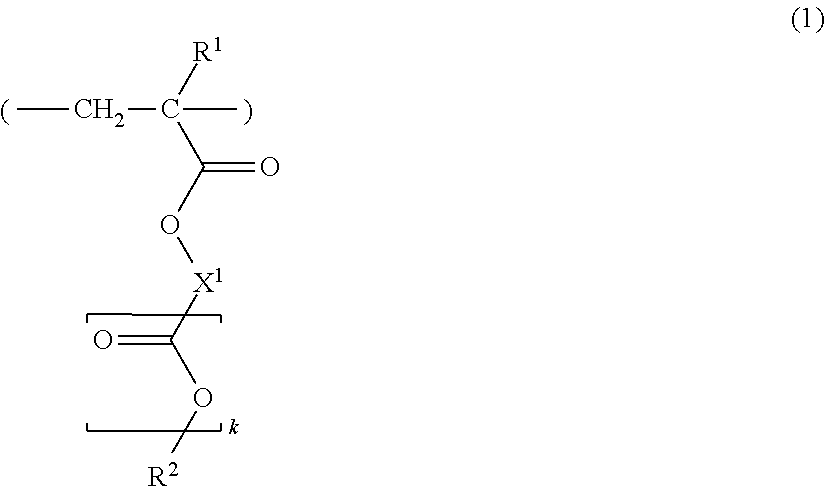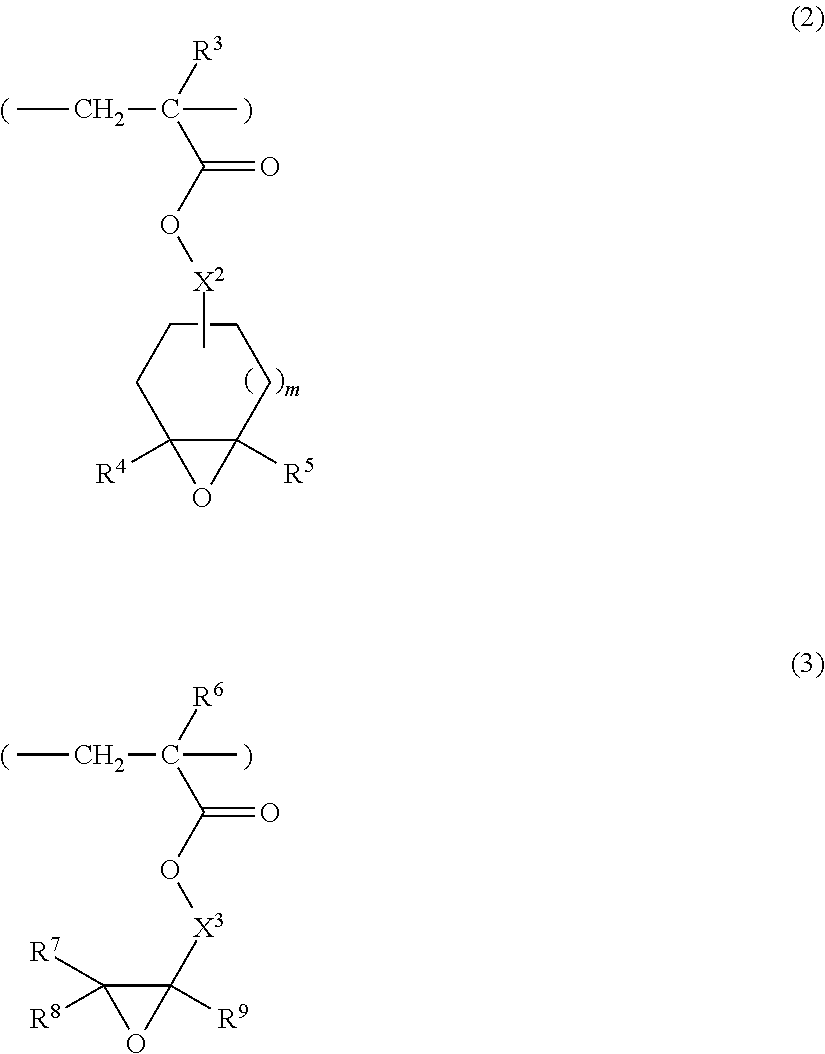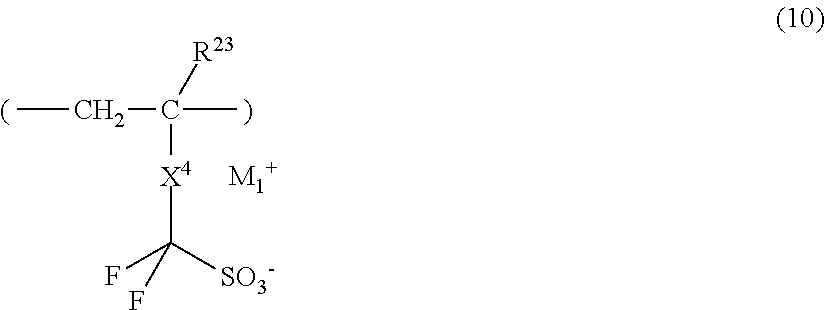Positive resist composition and patterning process
a composition and resist technology, applied in the direction of photosensitive materials, instruments, photomechanical equipment, etc., can solve the problems of resist material being affected by contrast degradation more serious, resist material being affected by acid diffusion, etc., to improve mef and collapse resistance, improve the effect of alkaline dissolution, and reduce the cost of scanning
Inactive Publication Date: 2013-04-25
SHIN ETSU CHEM IND CO LTD
View PDF6 Cites 21 Cited by
- Summary
- Abstract
- Description
- Claims
- Application Information
AI Technical Summary
Benefits of technology
The invention provides a positive resist composition that includes a polymer with specific recurring units that have an acid labile group, a cyclic hydrocarbon group containing ester, ether, carbonate, or sulfonate radicals, and an oxirane ring. The polymer is designed to increase alkaline dissolution under the action of an acid and to control acid diffusion, which prevents pattern collapse. The composition also includes a photoacid generator and a solvent. When a resist pattern is formed, the polymer in the exposed region is crosslinked with oxirane ring, which serves to control acid diffusion and prevent pattern collapse. The specific recurring units have been found to provide better pattern profile and resolution compared to other polymers.
Problems solved by technology
However, for the reasons that the projection lens uses a large amount of expensive CaF2 single crystal, the scanner thus becomes expensive, hard pellicles are introduced due to the extremely low durability of soft pellicles, the optical system must be accordingly altered, and the etch resistance of resist is low; the F2 lithography was postponed and instead, the early introduction of ArF immersion lithography was advocated (see Proc.
However, as the circuit line width is reduced, the influence of contrast being degraded by acid diffusion becomes more serious for the resist material.
The reason is that the pattern feature size is approaching the diffusion length of acid, and this causes a lowering of mask fidelity (known as mask error factor (MEF)), a degradation of pattern rectangularity, and unevenness of fine line pattern (known as line width roughness (LWR)).
Another problem which becomes more serious as the pattern feature size is reduced is pattern collapse.
The pattern is more likely to collapse, not only due to the influence of degraded contrast, but also because the critical dimension is reduced so that the area of contact with the substrate becomes narrower.
Because of stresses thus generated, the pattern collapses.
This proposal failed to provide a high transparency necessary to prevent a fine pattern from being tapered.
When acidic units are introduced into a base polymer in a positive resist material, however, they may function to increase the alkali dissolution rate of unexposed portions and reduce the dissolution contrast, with the function depending on their content.
This may invite a shortage of resolution and lead to a top-loss profile.
Therefore, these units are ineffective for mitigating swell and may sometimes serve to promote swell.
Method used
the structure of the environmentally friendly knitted fabric provided by the present invention; figure 2 Flow chart of the yarn wrapping machine for environmentally friendly knitted fabrics and storage devices; image 3 Is the parameter map of the yarn covering machine
View moreImage
Smart Image Click on the blue labels to locate them in the text.
Smart ImageViewing Examples
Examples
Experimental program
Comparison scheme
Effect test
example
[0120]Examples and Comparative Examples are given below by way of illustration and not by way of limitation. Weight average molecular weight (Mw) and number average molecular weight (Mn) are measured by gel permeation chromatography (GPC), and a dispersity (Mw / Mn) is computed therefrom. All parts are by weight (pbw). Me stands for methyl.
the structure of the environmentally friendly knitted fabric provided by the present invention; figure 2 Flow chart of the yarn wrapping machine for environmentally friendly knitted fabrics and storage devices; image 3 Is the parameter map of the yarn covering machine
Login to View More PUM
| Property | Measurement | Unit |
|---|---|---|
| wavelength | aaaaa | aaaaa |
| wavelength | aaaaa | aaaaa |
| size | aaaaa | aaaaa |
Login to View More
Abstract
A positive resist composition comprising (A) a polymer comprising recurring units containing an acid labile group, recurring units having a lactone ring, and recurring units having an oxirane ring, the polymer being adapted to increase alkaline dissolution under the action of an acid, (B) a photoacid generator, and (C) a solvent forms a fine pattern with improved LWR, improved MEF, rectangular profile, and collapse resistance.
Description
CROSS-REFERENCE TO RELATED APPLICATION[0001]This non-provisional application claims priority under 35 U.S.C. §119(a) on Patent Application No. 2011-233564 filed in Japan on Oct. 25, 2011, the entire contents of which are hereby incorporated by reference.TECHNICAL FIELD[0002]This invention relates to a positive resist composition and a pattern forming process using the composition. The positive resist composition lends itself to lithography using ArF excimer laser with wavelength 193 nm for micropatterning in the fabrication of semiconductor devices, especially immersion lithography where water is interposed between a projection lens and a wafer.BACKGROUND ART[0003]In the recent drive for higher integration densities and operating speeds in LSI devices, the pattern rule is made drastically finer. The photolithography which is currently on widespread use in the art is approaching the essential limit of resolution determined by the wavelength of a light source.[0004]As the light source...
Claims
the structure of the environmentally friendly knitted fabric provided by the present invention; figure 2 Flow chart of the yarn wrapping machine for environmentally friendly knitted fabrics and storage devices; image 3 Is the parameter map of the yarn covering machine
Login to View More Application Information
Patent Timeline
 Login to View More
Login to View More Patent Type & Authority Applications(United States)
IPC IPC(8): G03F7/004G03F7/20
CPCG03F7/0045G03F7/0046G03F7/2041G03F7/11G03F7/0397G03F7/004G03F7/0392G03F7/26H01L21/027H01L21/0271
Inventor TANIGUCHI, RYOSUKEKOBAYASHI, TOMOHIROHATAKEYAMA, JUNFUNATSU, KENJIKANAYAMA, MASAHIRO
Owner SHIN ETSU CHEM IND CO LTD
Features
- R&D
- Intellectual Property
- Life Sciences
- Materials
- Tech Scout
Why Patsnap Eureka
- Unparalleled Data Quality
- Higher Quality Content
- 60% Fewer Hallucinations
Social media
Patsnap Eureka Blog
Learn More Browse by: Latest US Patents, China's latest patents, Technical Efficacy Thesaurus, Application Domain, Technology Topic, Popular Technical Reports.
© 2025 PatSnap. All rights reserved.Legal|Privacy policy|Modern Slavery Act Transparency Statement|Sitemap|About US| Contact US: help@patsnap.com



